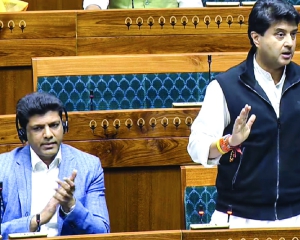With key sectors like pharmaceuticals and automobiles at risk, India could face an annual trade loss of up to $7 billion. There is an urgent need to find a diplomatic solution before it escalates into a full-fledged trade war
US President Donald Trump’s announcement of reciprocal tariffs on India, set to take effect on April 2, has caused serious concern in New Delhi. India’s high import taxes on American goods have long been a contentious issue, now straining trade relations further.
This move is not without consequences. It puts key exports such as jewelry and pharmaceuticals at risk, potentially leading to a significant annual loss of up to $7 billion for India. The looming question is: How much will this trade war cost India? Can New Delhi negotiate a way out before the damage is done? This million-dollar question keeps policymakers and trade experts on edge, underscoring the gravity of the situation.
India currently imposes much higher import taxes on US products than the US does on Indian goods, with a gap exceeding 10 percentage points. If the US lowers these tariffs, India’s exports to the US could decline by $2 Billion to $7 Billion in the financial year 2025-26, according to India Ratings and Research.
India maintains a trade surplus of over $36 Billion with the United States. The share of Indian exports to the US rose from 16.9 per cent in 2019-20 to 17.7 per cent in 2023-24, which may have prompted tariff actions by the Trump administration.
During his campaign, Trump criticised Indian tariffs on several US exports and suggested the possibility of imposing reciprocal taxes on Indian goods.
He believes it is time for the US to use tariffs to establish fairer trade. “Under the Trump administration, you will pay a tariff, and in some cases, the cost will be passed on to consumers,†he stated, insisting that the US will no longer tolerate unfair trading practices.
India imposes tariffs as high as 100 per cent on certain US products, creating what the Trump administration views as an unfair trade system. On April 2, reciprocal tariffs will take effect, meaning that any tariffs imposed by India will be matched by the US.
Additionally, if India uses non-monetary barriers to limit US market access, the US. will implement similar restrictions.
A report by Crisil Intelligence warns that these reciprocal tariffs could significantly harm India’s exports, which contribute about 22 per cent of the country’s GDP. Coupled with the challenges posed by slowing global trade growth and rising economic uncertainties, this situation could further strain India’s economy. In response, the Commerce and Industry Ministry has initiated stakeholder consultations to assess the potential impact of increased US tariffs.
According to a recent Crisil Intelligence report, India’s wide tariff gap with the US could have serious consequences if the US moves to equalise tariffs. Bloomberg economists echo this concern, noting that India’s economy may face significant setbacks.
Industry and trade experts in India argue that certain top exports-such as automobile parts, electronics, textiles, diamonds, jewelry, chemicals, and pharmaceuticals-could be severely affected if the US imposes restrictions. The most vulnerable sectors include chemicals, metal products, and jewelry, followed by automobiles, pharmaceuticals, and food products.
Furthermore, if President Trump penalises US. companies employing imported talent, India’s outsourcing and IT services industry could face significant constraints.
Commerce Minister Piyush Goyal began his US visit on Monday to meet with the new US Trade Representative, Jamieson Greer, who is overseeing the implementation of Trump’s tariff plan. Greer was also part of Trump’s first administration, which targeted China and, in doing so, opened export opportunities for India, particularly in the electronics sector.
Despite these tariff disputes, the United States remains India’s largest trading partner, with bilateral trade reaching $118.2 Billion in the 2024 fiscal year. India maintained a trade surplus of $36.8 Billion during this period. Trump has criticised India for imposing 100 per cent tariffs on automobiles, claiming such trade imbalances have allowed foreign countries to take advantage of the US for decades.
Like with other trade partners, the Trump administration intends to use tariffs as leverage to expand market access for American goods in India.
New Delhi must act quickly to address this challenge. One option is to engage in negotiations and lower tariffs. Both sides aim to increase market access, reduce tariff and non-tariff barriers, and deepen supply chain integration.
India should focus on bilateral negotiations to lower tariffs and diversify its export markets.
This strategy could help India navigate the impending trade challenges more effectively. A balanced, give-and-take approach will be key to overcoming this situation.
(The author is a popular columnist. Views expressed are personal)



























